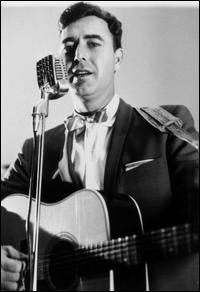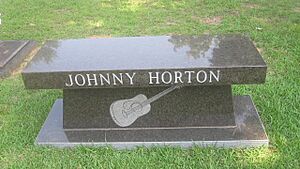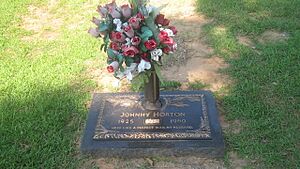Johnny Horton facts for kids
Quick facts for kids
Johnny Horton
|
|
|---|---|
 |
|
| Background information | |
| Birth name | John LaGale Horton |
| Also known as | The Singing Fisherman |
| Born | April 30, 1925 Los Angeles, California, U.S. |
| Died | November 5, 1960 (aged 35) Milano, Texas, U.S. |
| Genres | |
| Occupation(s) | Singer, musician, songwriter |
| Instruments | Guitar, vocals |
| Years active | 1950–1960 |
| Labels | |
| Associated acts |
|
John LaGale Horton (born April 30, 1925 – died November 5, 1960) was a famous American country, honky-tonk, and rockabilly singer and musician. He was very popular in the 1950s. He became well-known for his songs that told stories about history. These songs became big hits around the world.
One of his most famous songs was "The Battle of New Orleans" from 1959. It won a Grammy Award for Best Country & Western Recording in 1960. This song was also added to the Grammy Hall of Fame. In 2001, it was ranked No. 333 on the "Songs of the Century" list. His first song to reach No. 1 on the country charts was "When It's Springtime in Alaska (It's Forty Below)" in 1959.
In 1960, Johnny Horton had two more big hits: "Sink the Bismarck" and "North to Alaska". The song "North to Alaska" was even used in the opening of a John Wayne movie with the same name. Sadly, Johnny Horton died in a car accident in November 1960. He was at the top of his career, less than two years after his first big success. He is remembered in the Rockabilly Hall of Fame and the Louisiana Music Hall of Fame.
Contents
Early Life and Musical Start
Johnny Horton was born in Los Angeles, California, on April 30, 1925. He was the youngest of five children. He grew up in Rusk, in East Texas. His family often moved between Texas and southern California. They worked as farm workers who traveled to different places for jobs.
After finishing high school in Gallatin, Texas, in 1944, Johnny went to Lon Morris Junior College. He had a scholarship to play basketball. He also briefly attended Seattle University and Baylor University. However, he did not graduate from any of these colleges.
Johnny later went back to California. He got a job in the mail room at Selznick International Pictures. In 1948, he studied geology in Seattle for a short time. Then, he went to Alaska to search for gold. It was during this time that he started writing songs.
When he returned south, he entered a talent contest in Henderson, Texas. He won! This encouraged him to try for a music career back in California. He appeared on TV shows like Hometown Jamboree and had his own show called The Singing Fisherman. This led to him recording songs for the Cormac record label. He recorded 10 songs before the company closed in 1952.
Louisiana Hayride and Early Career
Johnny Horton started appearing regularly on a popular radio show called Louisiana Hayride. Because of this, he moved to Shreveport, Louisiana, where the show was recorded. He also signed a contract with Mercury Records and began recording music. His first song for Mercury was "First Train Headin' South."
In 1952, he started touring with his new band, the Rowley Trio. They called themselves The Singing Fisherman and the Rowley Trio. Later, they changed their name to Johnny Horton and the Roadrunners. The band included Johnny as the lead singer, Jerry Rowley on fiddle, Evelyn Rowley on piano, and Vera (Dido) Rowley on guitars.
Johnny's contract with Mercury ended in late 1954. His song "All for the Love of a Girl" was his best seller for that label. Johnny loved fishing, so he took a break from music and worked in a fishing tackle shop.
But the next year, his new manager, Tillman Franks, helped him get a contract with Columbia Records. They went to Nashville for their first recording session. Around this time, Johnny started to sing in a more rockabilly style. This was influenced by the music of Elvis Presley.
"Honky-Tonk Man" and Later Successes
Johnny Horton recorded "Honky-Tonk Man" on January 11, 1956, in Nashville. This was one of four songs he recorded that day. Famous musicians like Grady Martin and Harold Bradley played guitar. Bill Black, who was Elvis Presley's bassist, also played on the song.
Soon after, "Honky-Tonk Man" was released as a single. It was paired with another song from the same session, "I'm Ready if You're Willing." Johnny and his band, which included Tillman Franks on bass and Tommy Tomlinson on guitar, went on tour.
Billboard magazine reviewed "Honky-Tonk Man" positively. They said it had a "funky sound and pounding beat." The song became a hit, reaching No. 9 on the country charts.
His next single, "I'm a One Woman Man," also did well. Billboard called it a "smart and polished job." Johnny and his band toured across the United States and Canada to promote it. This song reached No. 7 on the country charts.
Another song, "I'm Coming Home," was also successful on the country charts. It was popular in both Southern and Northern cities.
Johnny Horton had even bigger hits later on. "The Battle of New Orleans" (written by Jimmy Driftwood) won a Grammy Award in 1960. It was also recognized as one of the "Songs of the Century." In 1960, he had two more major hits: "Sink the Bismarck" and "North to Alaska." The latter was used in the John Wayne movie North to Alaska.
Personal Life
Johnny Horton was married twice. His first marriage ended.
In September 1953, he married Billie Jean Jones. She was the widow of country music star Hank Williams. Johnny and Billie Jean had two daughters, Yanina (Nina) and Melody. Johnny also adopted Billie Jean's daughter, Jeri Lynn.
Death

On the night of November 4–5, 1960, Johnny Horton was traveling with two band members, Tommy Tomlinson and Tillman Franks. They were driving from Austin, Texas, to Shreveport, Louisiana. Their car crashed with an oncoming truck on a bridge near Milano, Texas.
Johnny Horton died on the way to the hospital. Tommy Tomlinson was badly hurt and later had his leg removed. Tillman Franks suffered head injuries. The truck driver also had injuries.
Johnny's funeral was held in Shreveport on November 8, 1960. His good friend, Johnny Cash, read from the Bible during the service. Johnny Horton is buried at Hillcrest Memorial Park and Mausoleum in Haughton, Louisiana.
Legacy
Johnny Cash was a close friend of Johnny Horton. When he heard about the accident, he was very sad. Cash later dedicated his song "When It's Springtime in Alaska (It's Forty Below)" to Horton on his album Personal File. He said, "Johnny Horton was a good old friend of mine."
Over the years, Johnny Horton's music has been re-released many times. You can find his songs in special box sets and compilation albums.
Johnny Horton was honored for his contributions to music. He was inducted into the Louisiana Music Hall of Fame. He was also added to the Delta Music Museum Hall of Fame in Ferriday, Louisiana, after his death.
Discography
Albums
| Year | Album | Chart Positions | RIAA | Label | |
|---|---|---|---|---|---|
| US Country | US | ||||
| 1959 | Johnny Horton | Dot | |||
| 1959 | The Fantastic Johnny Horton | Mercury | |||
| 1959 | The Spectacular Johnny Horton | Columbia | |||
| 1960 | Johnny Horton Makes History | ||||
| 1961 | Johnny Horton's Greatest Hits | 8 | Platinum | ||
| 1962 | Honky-Tonk Man | 104 | |||
| 1965 | I Can't Forget You | ||||
| 1966 | Johnny Horton Sings | ||||
| 1967 | Johnny Horton On Stage | 37 | |||
| 1968 | The Unforgettable Johnny Horton | ||||
| 1970 | On the Road | ||||
| The Legendary Johnny Horton | |||||
| 1971 | The Battle of New Orleans | ||||
| The World of Johnny Horton | |||||
Singles
| Year | Single (A-side, B-side) Both sides from same album except where indicated |
Chart Positions | Album | |
|---|---|---|---|---|
| US Country | US |
|||
| 1952 | "The Rest Of Your Life" b/w "This Won't Be The First Time" |
Non-album tracks | ||
| "I Won't Forget" b/w "The Child's Side Of Life" (from The Fantastic Johnny Horton) |
||||
| 1953 | "Plaid and Calico" b/w "Shadows On The Old Bayou" |
|||
| "Tennessee Jive" b/w "The Mansion You Stole" (from The Fantastic Johnny Horton) |
||||
| "I Won't Get Dreamy Eyed" b/w "S.S. Lure-Line" (from The Fantastic Johnny Horton) |
||||
| 1954 | "There'll Never Be Another Mary" b/w "No True Love" b/w "The Train with the Rhumba Beat" |
|||
| 1955 | "Journey With No End" b/w "Ridin' The Sunshine Special" (from The Fantastic Johnny Horton) |
|||
| "Hey Sweet, Sweet Thing" b/w "Big Wheels Rollin'" (from The Fantastic Johnny Horton) |
||||
| 1956 | "Honky-Tonk Man" b/w "I'm Ready, If You're Willing" (Original version, non-album track) |
9 | Honky-Tonk Man | |
| "I'm A One-Woman Man" b/w "I Don't Like I Did" (Non-album track) |
7 | |||
| 1957 | "I'm Coming Home" b/w "I Got A Hole In My Pirogue" |
11 | ||
| "The Woman I Need" b/w "She Knows Why" (from Honky-Tonk Man) |
9 | Non-album track | ||
| "I'll Do It Every Time" b/w "Let's Take The Long Way Home" (Non-album track) |
The Legendary Johnny Horton | |||
| "Lover's Rock" b/w "You're My Baby" |
Non-album tracks | |||
| 1958 | "Honky Tonk Hardwood Floor" b/w "The Wild One" |
Honky-Tonk Man | ||
| "All Grown Up" b/w "Counterfeit Love" |
8 | The Legendary Johnny Horton | ||
| 1959 | "When It's Springtime in Alaska (It's Forty Below)" b/w "Whispering Pines" |
1 | The Spectacular Johnny Horton | |
| "The Battle of New Orleans" b/w "All For The Love Of A Girl" (re-recording) |
1 | 1 | ||
| "Johnny Reb" / | 10 | 54 | Johnny Horton Makes History | |
| "Sal's Got A Sugar Lip" | 19 | 81 | Non-album track | |
| "I'm Ready, If You're Willing" (re-recording) b/w "Take Me Like I Am" (from The Legendary Johnny Horton) |
Johnny Horton's Greatest Hits | |||
| "They Shined Up Rudolph's Nose" b/w "The Electrified Donkey" |
Non-album tracks | |||
| 1960 | "Sink the Bismarck" b/w "The Same Old Tale The Crow Told Me" (differs from other versions and did not appear on any Columbia album) |
6 | 3 | Johnny Horton Makes History |
| "Johnny Freedom" b/w "Comanche (The Brave Horse)" |
69 | |||
| "North To Alaska" b/w "The Mansion You Stole" (re-recording) |
1 | 4 | Johnny Horton's Greatest Hits | |
| 1961 | "Sleepy-Eyed John" b/w "They'll Never Take Her Love from Me" |
9 | 54 | Honky-Tonk Man |
| "Ole Slew-Foot" b/w "Miss Marcy" (from The Legendary Johnny Horton) |
28 | 110 | ||
| 1962 | "Honky-Tonk Man"(re-release) b/w "Words" (from The Legendary Johnny Horton) |
11 | 96 | |
| 1963 | "All Grown Up" b/w "I'm A One-Woman Man" (from Honky-Tonk Man) Re-releases |
26 | The Legendary Johnny Horton | |
| "When It's Springtime In Alaska (It's Forty Below)" (re-release) b/w "Sugar-Coated Baby" (from The Unforgettable Johnny Horton) |
The Spectacular Johnny Horton | |||
| 1964 | "Hooray For That Little Difference" b/w "Tell My Baby I Love Her" (Non-album track) |
The Unforgettable Johnny Horton | ||
| "Lost Highway" b/w "The Same Old Tale The Crow Told Me" |
I Can't Forget You | |||
| 1965 | "I Just Don't Like This Kind Of Livin'" b/w "Rock Island Line" (from The World Of Johnny Horton) |
On The Road | ||
| 1966 | "Sam Magee" b/w "All For The Love Of A Girl" |
The Spectacular Johnny Horton | ||
| 1967 | "The Battle Of New Orleans" b/w "All For The Love Of A Girl" Re-release |
|||


